 |
 |
"Lots of people talk to animals,
not to many listen - that's the problem" Winnie the Pooh



The following case stories are indicative of the animal rescues and care given by All Wildlife Rescue and Education, Inc.
GRAND PRIX WILD FIRE SURVIVOR
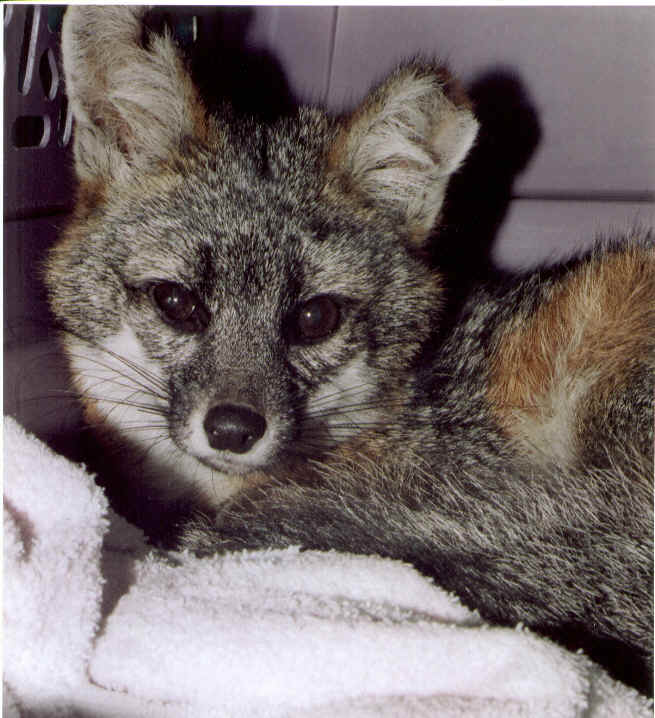

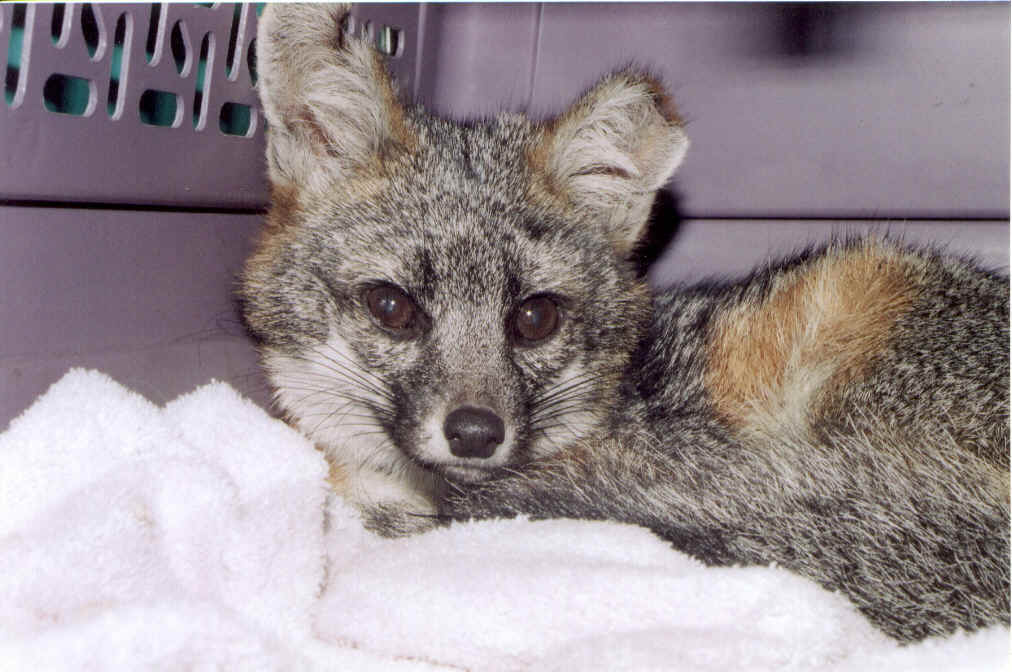
WILDFIRE VICTIM
RELEASED
A Gray Fox, a surviving victim of the Grand Prix Wildfire, was released back into the wild on Saturday, 22 November 2003
On the 29th of October, this burnt and injured Gray Fox was spotted in what was left of the branches of a burnt-out tree near the corner of Mt Baldy Drive North and Shinn Road by a SCE biologist, who in turn reported the sighting to the Inland Valley Humane Society & SPCA,
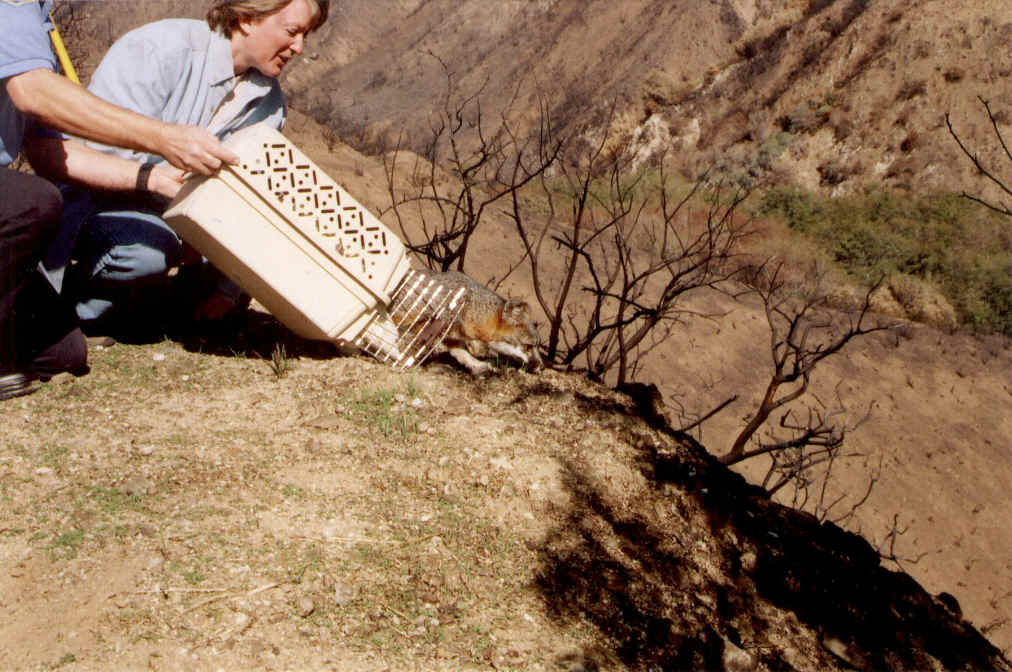
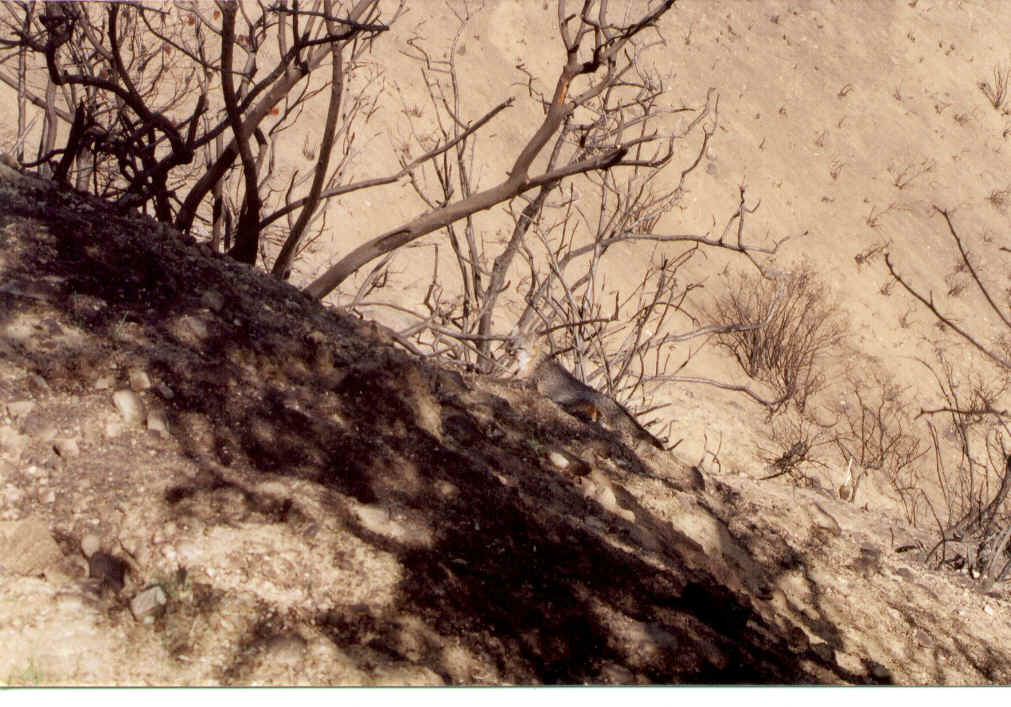
Officer Taber and the SCI Biologist releasing Smoky where he was found Smoky back at home and our last glimpse of him
One day in November, the Long Beach animal
control brought us an injured Peregrine Falcon; ![]() a highly
endangered species. Upon receiving the falcon, it was quite apparent that there was a
problem with its wing. Radiographs taken showed numerous fractures to the humerus (This is
a bone on the upper part of the wing, or the bone between your shoulder and elbow. ). The
fractures consisted of 4 large pieces and 3 smaller pieces. Normally a condition such as
this would spell certain doom for the falcon but thanks to Dr. Douglas Mader of The Long
Beach Animal Hospital, who spent over four hours meticulously reconstructing the
fragmented humerus.
a highly
endangered species. Upon receiving the falcon, it was quite apparent that there was a
problem with its wing. Radiographs taken showed numerous fractures to the humerus (This is
a bone on the upper part of the wing, or the bone between your shoulder and elbow. ). The
fractures consisted of 4 large pieces and 3 smaller pieces. Normally a condition such as
this would spell certain doom for the falcon but thanks to Dr. Douglas Mader of The Long
Beach Animal Hospital, who spent over four hours meticulously reconstructing the
fragmented humerus.
Upon recovery and healing from surgery, the falcon was transferred to a flight cage where it began building muscle tone and sharpening its flying agility. We were able to place this Peregrine Falcon with the United States Fish And Wildlife Service which has a re-population project in Idaho. This Peregrine Falcon is now flying free in the wilds of Idaho and is half of a breeding pair.
A great horned owl
![]() was given to us by the South East Area Animal Control
Agency. The owl had suffered a major head trauma rendering him totally blind, but was
otherwise in good health.
was given to us by the South East Area Animal Control
Agency. The owl had suffered a major head trauma rendering him totally blind, but was
otherwise in good health.
Realizing this owl would probably be non-releasable, due to the long treatment and rehabilitation period required to treat his lost sight, we started looking for an acceptable and properly licensed facility that would accept whom we now call "Aristotle". Aristotle’s sight never returned but he has adapted to his new world very well and is in a facility that has the proper resources to care for him. Aristotle is now fostering orphaned baby great horn owls.
A somewhat frantic and concerned citizen
contacted us, saying he had an "injured hawk of some sort." He had managed to
corner this hawk in his backyard but was not sure what to do with the injured raptor. ![]() After many frustrating phone calls to assorted local
departments and agencies, he contacted the California Fish and Game office. After hearing
the situation, they instructed him to contact us. Dave Thraen, current Executive Director
of AWRE, had been working with the dept. and they were familiar with his efforts and
abilities. Promptly responding to the call, we found a very aggressive Coopers Hawk with a
broken wing. After a quick capture and radiograph, it was determined the raptor had a
broken radius (similar to the smaller bone in a person's forearm). The Cooper's Hawk was
started on anti-biotics and his wing immobilized.
After many frustrating phone calls to assorted local
departments and agencies, he contacted the California Fish and Game office. After hearing
the situation, they instructed him to contact us. Dave Thraen, current Executive Director
of AWRE, had been working with the dept. and they were familiar with his efforts and
abilities. Promptly responding to the call, we found a very aggressive Coopers Hawk with a
broken wing. After a quick capture and radiograph, it was determined the raptor had a
broken radius (similar to the smaller bone in a person's forearm). The Cooper's Hawk was
started on anti-biotics and his wing immobilized.
After seven days we took another radiograph and verified the broken bone was knitting together correctly. After another seven days the wing wrap was removed and the hawk was given a couple of days to build muscle tone and stamina.
After two days the hawk was taken to the area in which he was found and successfully released back into the wild.
For more information about Raptors; Owls and
Hawks among other birds, please check out Birds of Prey. ![]() Please be aware
that this site is not in anyway affiliated with All Wildlife Rescue and Education, Inc. A
link to it is provided for your convenience only.
Please be aware
that this site is not in anyway affiliated with All Wildlife Rescue and Education, Inc. A
link to it is provided for your convenience only.
AWRE recently received a call from Pam, a
concerned citizen, who was extremely upset about the conditions a Red Eared Slider ![]() at her local pet shop was being kept in. The Slider weighed
2.5Kg, which is exceptionally large for this species, and was housed in a box less than
2ft. square. It had no access to a pond or swimming area, was kept under a bunch of
shelves and received little, if any, sunlight.
at her local pet shop was being kept in. The Slider weighed
2.5Kg, which is exceptionally large for this species, and was housed in a box less than
2ft. square. It had no access to a pond or swimming area, was kept under a bunch of
shelves and received little, if any, sunlight.
The slider, whom Pam now called "Tillie", had swelling on it's neck that was sol large it prevented her retracting her head into her shell. Pam wanted to know what could be done to save Tillie from this abusive situation.
We suggested that she try to stay on the good side of the pet shop owner in order to maintain a more open, cooperative line of communication. We also suggested Pam explain to the pet shop's owner what great PR he and his store would receive for putting concern for "Tillie's welfare" ahead of any business concern We made it clear that once Tillie was given a clean bill of health, she would be placed with a properly licensed wildlife preserve and educational facility.
Pam did her best and with perseverance and conviction, she was finally able to convince the owner to agree. Pam brought Tillie to AWRE where we went to work examining and treating Tillie. We were fortunate to have Dr. Bill Ridgeway, D.V.M., of Long Beach Animal Hospital, examine Tillie. The mass on her neck was aspirated, then drained. Dr. Ridgeway was able to pull 26ml. of fluid from her neck. This fluid removal returned her neck to it's normal size enabling the head to retract back into the shell.
Tillie was then placed in our rehab. pond area and allowed to recuperate. Once Tillie was strong and healthy, she was taken to her new pond where she'll be able to live life like a normal turtle. Thanks to concerned citizen's like Pam, this story has a happy ending.
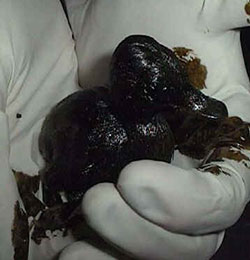 If you look closely at the blob
of oil in the photograph on the right you will notice it has eyes, a bill, and a pair of
exceptionally large webbed feet. This is an oil soaked Mallard Duckling, one of a clutch
of eight; all soaked in oil. The eight blobs of oil were delivered to the Long Beach Animal Hospital (LBAH)where the
first concern was to prevent Hypothermia (a condition where the body cannot maintain its'
proper body temperature and is often fatal).
If you look closely at the blob
of oil in the photograph on the right you will notice it has eyes, a bill, and a pair of
exceptionally large webbed feet. This is an oil soaked Mallard Duckling, one of a clutch
of eight; all soaked in oil. The eight blobs of oil were delivered to the Long Beach Animal Hospital (LBAH)where the
first concern was to prevent Hypothermia (a condition where the body cannot maintain its'
proper body temperature and is often fatal).



This page was last updated:
May 27, 2016
All information is the sole property of All Wildlife Rescue and Education, Inc.
Problems,
questions or comments about the site: Webmaster@awre.org